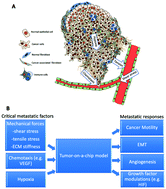Our official English website, www.x-mol.net, welcomes your
feedback! (Note: you will need to create a separate account there.)
Tumor-on-a-chip for integrating a 3D tumor microenvironment: chemical and mechanical factors.
Lab on a Chip ( IF 6.1 ) Pub Date : 2020-03-03 , DOI: 10.1039/c9lc00550a L Wan 1 , C A Neumann 2 , P R LeDuc 1
Lab on a Chip ( IF 6.1 ) Pub Date : 2020-03-03 , DOI: 10.1039/c9lc00550a L Wan 1 , C A Neumann 2 , P R LeDuc 1
Affiliation

|
Tumor progression, including metastasis, is significantly influenced by factors in the tumor microenvironment (TME) such as mechanical force, shear stress, chemotaxis, and hypoxia. At present, most cancer studies investigate tumor metastasis by conventional cell culture methods and animal models, which are limited in data interpretation. Although patient tissue analysis, such as human patient-derived xenografts (PDX), can provide important clinical relevant information, they may not be feasible for functional studies as they are costly and time-consuming. Thus, in vitro three-dimensional (3D) models are rapidly being developed that mimic TME and allow functional investigations of metastatic mechanisms and drug responses. One of those new 3D models is tumor-on-a-chip technology that provides a powerful in vitro platform for cancer research, with the ability to mimic the complex physiological architecture and precise spatiotemporal control. Tumor-on-a-chip technology can provide integrated features including 3D scaffolding, multicellular culture, and a vasculature system to simulate dynamic flow in vivo. Here, we review a select set of recent achievements in tumor-on-a-chip approaches and present potential directions for tumor-on-a-chip systems in the future for areas including mechanical and chemical mimetic systems. We also discuss challenges and perspectives in both biological factors and engineering methods for tumor-on-a-chip progress. These approaches will allow in the future for the tumor-on-a-chip systems to test therapeutic approaches for individuals through using their cancerous cells gathered through approaches like biopsies, which then will contribute toward personalized medicine treatments for improving their outcomes.
中文翻译:

用于集成 3D 肿瘤微环境的肿瘤芯片:化学和机械因素。
肿瘤进展(包括转移)受到肿瘤微环境(TME)中的因素(例如机械力、剪切应力、趋化性和缺氧)的显着影响。目前,大多数癌症研究通过传统的细胞培养方法和动物模型来研究肿瘤转移,但数据解释有限。尽管患者组织分析(例如人类患者来源的异种移植物(PDX))可以提供重要的临床相关信息,但它们对于功能研究来说可能不可行,因为它们成本高昂且耗时。因此,模拟 TME 并允许对转移机制和药物反应进行功能研究的体外三维 (3D) 模型正在迅速开发。这些新的 3D 模型之一是肿瘤芯片技术,它为癌症研究提供了强大的体外平台,能够模拟复杂的生理结构和精确的时空控制。肿瘤芯片技术可以提供集成功能,包括 3D 支架、多细胞培养和脉管系统,以模拟体内动态流动。在这里,我们回顾了芯片上肿瘤方法的一系列最新成就,并提出了芯片上肿瘤系统未来在机械和化学模拟系统等领域的潜在方向。我们还讨论了芯片上肿瘤进展的生物因素和工程方法方面的挑战和前景。这些方法将允许未来芯片上肿瘤系统通过使用通过活检等方法收集的癌细胞来测试个体的治疗方法,这将有助于个性化的医学治疗以改善他们的结果。
更新日期:2020-03-03
中文翻译:

用于集成 3D 肿瘤微环境的肿瘤芯片:化学和机械因素。
肿瘤进展(包括转移)受到肿瘤微环境(TME)中的因素(例如机械力、剪切应力、趋化性和缺氧)的显着影响。目前,大多数癌症研究通过传统的细胞培养方法和动物模型来研究肿瘤转移,但数据解释有限。尽管患者组织分析(例如人类患者来源的异种移植物(PDX))可以提供重要的临床相关信息,但它们对于功能研究来说可能不可行,因为它们成本高昂且耗时。因此,模拟 TME 并允许对转移机制和药物反应进行功能研究的体外三维 (3D) 模型正在迅速开发。这些新的 3D 模型之一是肿瘤芯片技术,它为癌症研究提供了强大的体外平台,能够模拟复杂的生理结构和精确的时空控制。肿瘤芯片技术可以提供集成功能,包括 3D 支架、多细胞培养和脉管系统,以模拟体内动态流动。在这里,我们回顾了芯片上肿瘤方法的一系列最新成就,并提出了芯片上肿瘤系统未来在机械和化学模拟系统等领域的潜在方向。我们还讨论了芯片上肿瘤进展的生物因素和工程方法方面的挑战和前景。这些方法将允许未来芯片上肿瘤系统通过使用通过活检等方法收集的癌细胞来测试个体的治疗方法,这将有助于个性化的医学治疗以改善他们的结果。











































 京公网安备 11010802027423号
京公网安备 11010802027423号